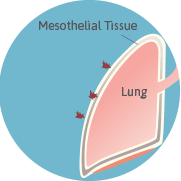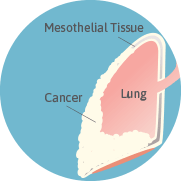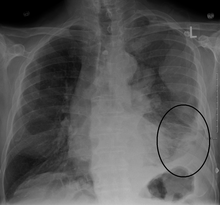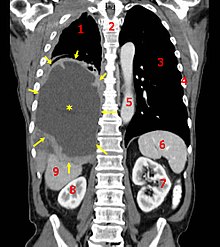Blood Tests and Biomarkers
While imaging tests and tissue biopsies are the most
common methods for diagnosing mesothelioma, blood tests can also help
doctors identify the disease. These blood tests look for certain
indicators of disease, known as biomarkers, in a patient’s blood.
MESOMARK Assay
Dr. Snehal Smart of Asbestos.com talks about the MESOMARK assay.
Fast Fact: In a
study of 1,086 blood samples, 99 percent of the healthy specimens
displayed SMRP levels at or below the reference value used to indicate
the presence of an asbestos-related cancer.
MESOMARK can also help doctors track the progression of a
mesothelioma tumor. In most cases, SMRP levels increase as the disease
progresses. In one study, 10 out of 18 patients whose imaging scans
indicated progressive disease also displayed an SMRP level increase of
at least 30 percent on a follow-up MESOMARK assay.Free Mesothelioma Guide
Free information, books, wristbands and more for patients and caregivers.
The MESOMARK Assay Procedure
The MESOMARK assay is completed in two steps. First, the doctor takes two small blood samples from the patient's vein. Each sample contains about two teaspoons of blood. The doctor then sends the samples to a laboratory for official analysis. The patient is free to go home after the procedure, and is generally not at risk for any significant side effects.At the laboratory, technicians add several antibodies to the blood samples that bind to the protein fragments. They then stir the mixture and place it in a laboratory instrument called a plate reader. Computer software analyzes the contents of the blood sample and provides a measurement of the amount of SMRP-bound antibodies present.
Percent of patients who had elevated serum SMRP levels

In one study of 40
subjects with a history of asbestos exposure, seven individuals
displayed elevated SMRP levels. Within five years of the blood test,
three of these patients were diagnosed with the disease. None of the 33
patients with normal SMRP levels developed mesothelioma in the next
eight years.
N-ERC/Mesothelin Test
Created in Japan, this blood test detects a form of mesothelin known
as N-ERC/mesothelin. This test is similar to MESOMARK in its design, but
uses a specially designed enzyme test to increase accuracy.
The N-ERC/mesothelin test is 95 percent effective at detecting mesothelioma, but only 76 percent effective at ruling it out.
Even though this test is more accurate than MESOMARK, it cannot serve as a single test to diagnosed mesothelioma because mesothelin is produced by other cancers than mesothelioma.
The N-ERC test is more accurate at detecting epithelial mesothelioma than sarcomatoid. This is because epithelial mesothelioma produces more mesothelin than the sarcomatoid cell type.
The N-ERC/mesothelin test is 95 percent effective at detecting mesothelioma, but only 76 percent effective at ruling it out.
Even though this test is more accurate than MESOMARK, it cannot serve as a single test to diagnosed mesothelioma because mesothelin is produced by other cancers than mesothelioma.
The N-ERC test is more accurate at detecting epithelial mesothelioma than sarcomatoid. This is because epithelial mesothelioma produces more mesothelin than the sarcomatoid cell type.
Fibulin-3 Test
Fibulin-3 is a protein overexpressed by mesothelioma and found in pleural fluid and blood.
Mesothelioma specialist Dr. Harvey Pass helped pioneer the fibulin-3 test for mesothelioma. In 2012, he co-authored a study that found fibulin-3 96.7 percent effective at detecting mesothelioma and 95.5 percent effective at ruling it out.
Pass also reported that when used to detect pleural mesothelioma among asbestos-exposed persons, the fibulin test had 100 percent sensitivity and 94.1 percent specificity. However, when the test was used on archived blood serum samples from mesothelioma patients, it was not as accurate.
Other studies found fibulin-3 slightly less effective, which could be explained by variances in the patients studied.
For example, an Egyptian study found the test 88 percent effective at deciphering pleural mesothelioma from other cancers that had spread to the pleura. They also found it 100 percent accurate at discriminating malignant mesothelioma from benign pleural effusions.
A 2014 Australian study found mesothelin superior to fibulin-3 at detecting mesothelioma, but found fibulin-3 had more prognostic value than mesothelin. Bigger studies and more research are necessary to determine the diagnostic and prognostic value of fibulin-3.
Mesothelioma specialist Dr. Harvey Pass helped pioneer the fibulin-3 test for mesothelioma. In 2012, he co-authored a study that found fibulin-3 96.7 percent effective at detecting mesothelioma and 95.5 percent effective at ruling it out.
Pass also reported that when used to detect pleural mesothelioma among asbestos-exposed persons, the fibulin test had 100 percent sensitivity and 94.1 percent specificity. However, when the test was used on archived blood serum samples from mesothelioma patients, it was not as accurate.
Other studies found fibulin-3 slightly less effective, which could be explained by variances in the patients studied.
For example, an Egyptian study found the test 88 percent effective at deciphering pleural mesothelioma from other cancers that had spread to the pleura. They also found it 100 percent accurate at discriminating malignant mesothelioma from benign pleural effusions.
A 2014 Australian study found mesothelin superior to fibulin-3 at detecting mesothelioma, but found fibulin-3 had more prognostic value than mesothelin. Bigger studies and more research are necessary to determine the diagnostic and prognostic value of fibulin-3.
Other Biomarker-Based Blood Tests
Some other laboratory blood tests screen a patient for osteopontin
and megakaryocyte potentiation factor (MPF). Levels of these biomarkers
are also significantly higher in the blood of mesothelioma patients
compared with healthy individuals or patients with other cancers.
Laboratory technicians measure these biomarkers in the blood with a
method known as enzyme-linked immunoabsorbent assay (ELISA).
Osteopontin and MPF blood tests are not quite dependable enough to make an official diagnosis. Osteopontin and MPF lack specificity as diagnostic markers, meaning there is not a high enough likelihood that a positive test result truly indicates a patient has mesothelioma. However, the blood tests that rely on these biomarkers can play a significant role in monitoring the disease.
Osteopontin and MPF blood tests are not quite dependable enough to make an official diagnosis. Osteopontin and MPF lack specificity as diagnostic markers, meaning there is not a high enough likelihood that a positive test result truly indicates a patient has mesothelioma. However, the blood tests that rely on these biomarkers can play a significant role in monitoring the disease.



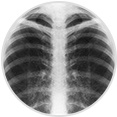







 Medical History Review
Medical History Review
 Occupational History Review
Occupational History Review
 Basic Physical Exam
Basic Physical Exam
 Discussion of Symptoms
Discussion of Symptoms

